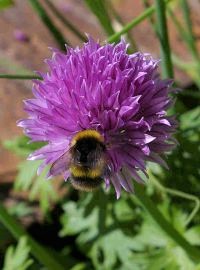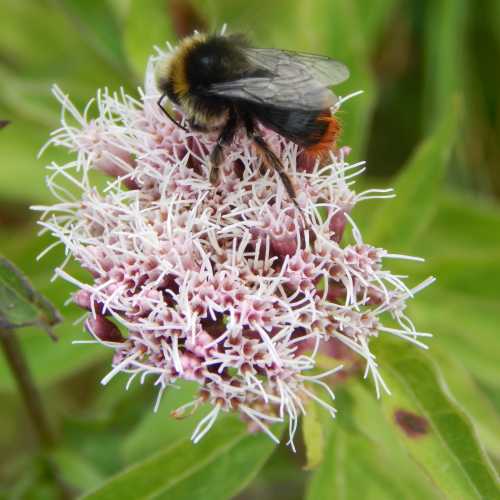Bumble Bee Foraging Behaviour
Updated: 15th February 2024
Common Questions About Bumble Bee Foraging Behaviours
Bumble bee foraging behaviours are complex, with many
variables, such as:
- How far will bumble bees fly to find food? (What is the foraging range?
- Do bumble bees waggle dance?
- How do bumble bees know which flowers to visit?
- At that time of the day do bumble bees forage?
- Are bumble bees attracted to particular flowers – and do they stick to specific types (flower constancy)? Do bumble bees nectar rob?
Here we explore these themes.
1. How far do bumble bees fly for food? Bumble bee foraging range
Answer:
There is some evidence suggesting that foraging range varies according to species (i.e. some forage closer to the nest, others further away). It is also possible that there is some correlation between foraging range and nest (colony) size, with bumble bee species from typically smaller colonies tending to forage closer to home (less than 1500m) than those with larger colony size - i.e. more than 2 km from the nest (Walther-Hellwig and Frankl 20001).
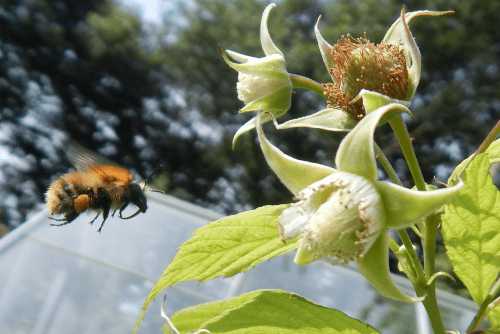 Bumble bee in flight toward raspberry flower.
Bumble bee in flight toward raspberry flower.However, to my knowledge, the data on bumble bee foraging range does not provide a clear picture, and could also depend on environmental factors (such as availability of nectar and pollen-rich flowers) as well as factors such as study design.
You can read more about how far bees fly with links to scientific studies.
2. Do bumble bees ‘waggle dance’?
Answer:
It is believed that bumble bees do not perform a waggle dance to communicate food locations as such.
However, returning foragers run around the nest emitting a pheromone which is believed to stimulate foraging behaviour (Dornhaus and Chittka 19992, 20013).
Interestingly, stingless bees appear to perform a kind of dance which some may find reminiscent of the honey bee waggle dance.
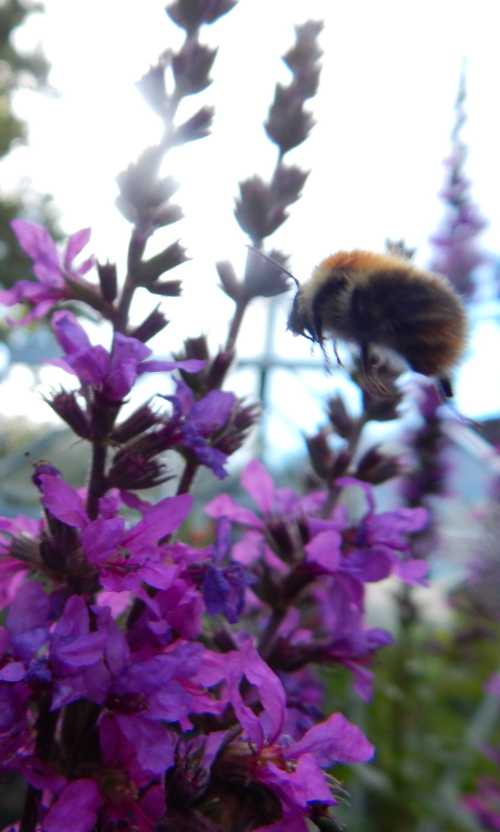 Bumble bee flying toward purple loosestrife.
Bumble bee flying toward purple loosestrife.
3. How do bumble bees know which flowers to visit?
Answer:
Some evidence suggests that bumble bees may learn about rewarding flower species (i.e. species of flowers which provide lots of nectar and pollen), directly through observing other conspecific foragers (i.e. bees of the same species) (Worden and Papaj 20054).
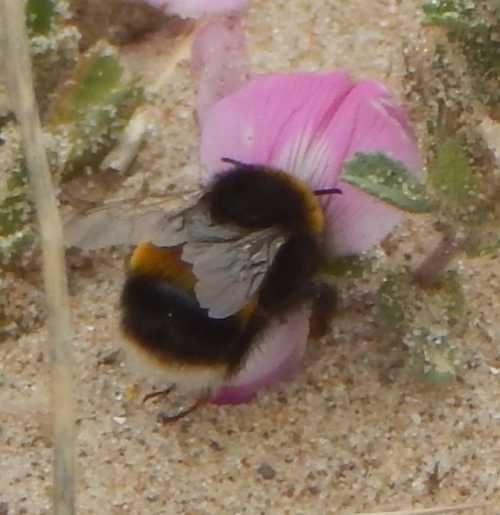 Bumble bee foraging on restharrow.
Bumble bee foraging on restharrow.Bumble bees will also switch flower species to a more rewarding alternative more quickly if other bees are foraging there than if alone, because they are attracted to occupied flowers (Leadbeater and Chittka 20075).
However, despite a willingness to forage together, they are able to detect and avoid visiting flowers which have recently been visited by other bees. How?
Bees have an oily residue on the whole surface of their bodies, including the feet. Research has suggested that upon visiting flowers, at least some species leave a trace of this residue behind.
Honey bees, for example, use these temporary scent marks to act as a repellent in order that other honey bees can distinguish and reject flowers that have recently been visited by themselves or their colony members. This means they avoid wasting time by exploring and probing empty flowers.
It has been found that bumble bee species also exhibit this behaviour. The bumble bee species Bombus terrestris and Bombus pascuorum were able to distinguish and avoid flowers which had previously been visited by conspecifics and other Bombus species. (Goulson, Hawson and Stout 19986).
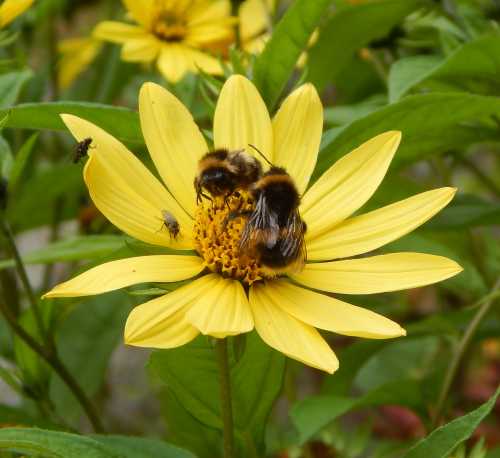 Bumble bees foraging on Helianthus.
Bumble bees foraging on Helianthus.4. At what time of the day do bumble bees forage?
A study by Herrera (19907) showed that in two common garden species studied (Bombus
terrestris and Bombus lucorum), foraging activity peaked early (5am – 7am) and
late (5 – 7 pm). Note that ‘peak’
nevertheless can imply that some foraging may also occur outside of those
times.
Manufacturers of pesticides (including garden insecticides) may advise their application during the morning, to minimize the risk to foraging bees, however, in light of the evidence, this claim may merit further investigation.
5. Are bumble bees attracted to particular flowers – and do they stick to specific types (flower constancy)?
It is believed that bees learn to favour flowers that have previously provided a reward, thus they continue to forage on the species whilst the reward remains available.
This makes for efficient foraging, since the complex shapes of some flowers means that bees may have to develop the skill of gaining access to the pollen and nectar stores within.
Once the bee has learned how to efficiently tackle a flower species, it therefore makes sense to exploit it for food whilst the nourishment remains available.
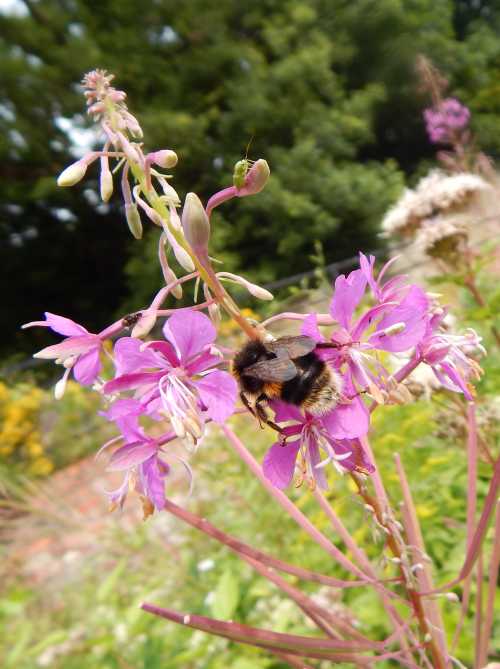 Bumble bee on rosebay willow herb.
Bumble bee on rosebay willow herb.It is well known that different bumble bee species have different tongue lengths. Whilst it seems this could affect the foraging behaviour of bumble bees, it should be noted that even within a single colony, tongue length can vary, simply because of the varied sizes of the workers and males.
Bumble bees may also engage in nectar robbing if they are attracted by a large volume of nectar, but cannot easily reach it.
Bombus, as a genus, is regarded categorized as long-tongued, but some bumble bee species have shorter tongues than others. Those species with shorter tongues are more likely to engage in nectar robbing than longer-tongued species. Read more about different flower shapes.
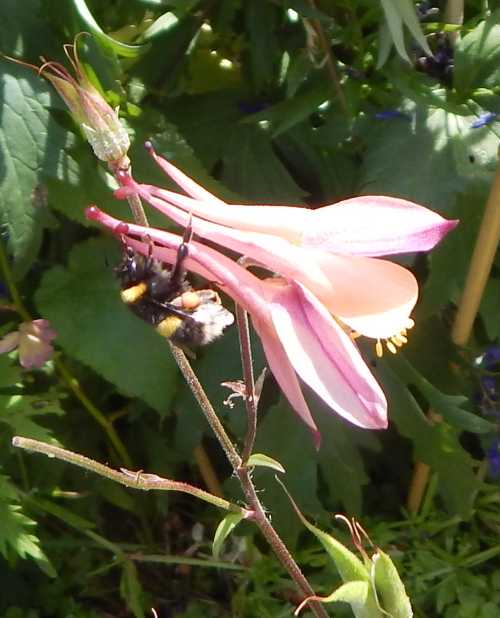 Bumble bee nectar robbing aquilegia flower.
Bumble bee nectar robbing aquilegia flower.Flower shapes also play a role in that some flower species are visited only by particular bees. For instance Hypericum vouytcheuse are visited for pollen only by Bombus lucorum and Bombus pascuorum workers using buzz foraging. The fact that only these species visit the plants minimises competition for the food reward offered.
References
1. Walther-Hellwig, K., Frankl, R. Foraging Distances of Bombus muscorum, Bombus lapidarius, and Bombus terrestris (Hymenoptera, Apidae). Journal of Insect Behavior 13, 239–246 (2000). https://doi.org/10.1023/A:1007740315207.
2. Dornhaus, A., Chittka, L. Evolutionary origins of bee dances. Nature 401, 38 (1999). https://doi.org/10.1038/43372
3. Dornhaus, Anna, and Lars Chittka. “Food Alert in Bumblebees (Bombus Terrestris): Possible Mechanisms and Evolutionary Implications.” Behavioral Ecology and Sociobiology, vol. 50, no. 6, 2001, pp. 570–76, http://www.jstor.org/stable/4602007.
4. Worden Bradley D and Papaj Daniel R 2005 Flower choice copying in bumblebees Biol. Lett.1504–507 http://doi.org/10.1098/rsbl.2005.0368
5. Leadbeater E, Chittka L. A new mode of information transfer in foraging bumblebees? Curr Biol. 2005 Jun 21;15(12):R447-8. doi: 10.1016/j.cub.2005.06.011. PMID: 15964260.
6. Goulson D, Hawson SA, Stout JC. Foraging bumblebees avoid flowers already visited by conspecifics or by other bumblebee species. Anim Behav. 1998 Jan;55(1):199-206. doi: 10.1006/anbe.1997.0570. PMID: 9480686.
7. Herrera, Carlos M. “Daily Patterns of Pollinator Activity, Differential Pollinating Effectiveness, and Floral Resource Availability, in a Summer-Flowering Mediterranean Shrub.” Oikos, vol. 58, no. 3, 1990, pp. 277–88, https://doi.org/10.2307/3545218.
